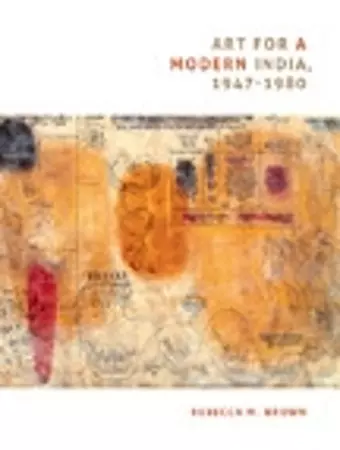Art for a Modern India, 1947-1980
Format:Hardback
Publisher:Duke University Press
Published:17th Mar '09
Currently unavailable, and unfortunately no date known when it will be back

A look at how prominent Indian visual artists created modern art for the postcolonial nation in the years between India's independence in 1947 and 1980
Following India’s independence in 1947, Indian artists creating modern works of art sought to maintain a local idiom, an “Indianness” representative of their newly independent nation, while connecting to modernism, an aesthetic then understood as both universal and presumptively Western. These artists depicted India’s precolonial past while embracing aspects of modernism’s pursuit of the new, and they challenged the West’s dismissal of non-Western places and cultures as sources of primitivist imagery but not of modernist artworks. In Art for a Modern India, Rebecca M. Brown explores the emergence of a self-conscious Indian modernism—in painting, drawing, sculpture, architecture, film, and photography—in the years between independence and 1980, by which time the Indian art scene had changed significantly and postcolonial discourse had begun to complicate mid-century ideas of nationalism.
Through close analyses of specific objects of art and design, Brown describes how Indian artists engaged with questions of authenticity, iconicity, narrative, urbanization, and science and technology. She explains how the filmmaker Satyajit Ray presented the rural Indian village as a socially complex space rather than as the idealized site of “authentic India” in his acclaimed Apu Trilogy, how the painter Bhupen Khakhar reworked Indian folk idioms and borrowed iconic images from calendar prints in his paintings of urban dwellers, and how Indian architects developed a revivalist style of bold architectural gestures anchored in India’s past as they planned the Ashok Hotel and the Vigyan Bhavan Conference Center, both in New Delhi. Discussing these and other works of art and design, Brown chronicles the mid-twentieth-century trajectory of India’s modern visual culture.
“[R]ecommended for libraries with graduate programs in art history and for others looking to expand their modern and non-Western art history collections.” - Melissa Aho, ARLIS/NA Reviews
“An interesting contribution, this book will be useful in general and undergraduate libraries. Summing Up: Recommended. Lower-level undergraduates through faculty/ researchers; general readers.” - E. Findly, Choice
“Bringing together a range of disparate but linked examples, Brown's text makes for stimulating reading–an essential text for any student of the arts, postcolonialism, and the interaction of science and arts in the postcolonial context.” - Aparna Sharma, Leonardo
“Rebecca Brown’s elegant and conceptually driven account of modernism focuses on the decades following Independence. . . . Brown’s approach is highly satisfying. By cutting across media and juxtaposing artists whose aesthetic commitments and backgrounds are presented as incommensurate within the internal debates of the Indian art world, Brown challenges the specialist. But she also gives the general reader an overarching sense of what conceptual problems faced Indian artists and, just as importantly, why those problems emerged as such. It is a particularly fitting approach for a period of art history that is dominated by studies focusing on single artists, artist groups, and institutions.” - Karin Zitzewitz, Art History
“Rebecca M. Brown weaves a rich and layered narrative of Indian postindependence art, connecting painting with a wide range of references that include the architecture of Charles Correa, the ‘high’ cinema of Satyajit Ray, and the demotic art of Bollywood. All the while she balances theoretical sophistication with penetrating insights into the singular achievements of these artists as they negotiate the predicament of local versus global modernism. In the process, she unravels the indebtedness of modernity to colonialism. There has long been a crying need for such a work, and Brown’s pioneering opus fulfills this admirably.”—Partha Mitter, author of The Triumph of Modernism: India’s Artists and the Avant-Garde, 1922–1947
“[R]ecommended for libraries with graduate programs in art history and for others looking to expand their modern and non-Western art history collections.” -- Melissa Aho * ARLIS/NA Reviews *
“An interesting contribution, this book will be useful in general and undergraduate libraries. Summing Up: Recommended. Lower-level undergraduates through faculty/ researchers; general readers.” -- E. Findly * Choice *
“Bringing together a range of disparate but linked examples, Brown's text makes for stimulating reading–an essential text for any student of the arts, postcolonialism, and the interaction of science and arts in the postcolonial context.” -- Aparna Sharma * Leonardo Reviews *
“Rebecca Brown’s elegant and conceptually driven account of modernism focuses on the decades following Independence. . . . Brown’s approach is highly satisfying. By cutting across media and juxtaposing artists whose aesthetic commitments and backgrounds are presented as incommensurate within the internal debates of the Indian art world, Brown challenges the specialist. But she also gives the general reader an overarching sense of what conceptual problems faced Indian artists and, just as importantly, why those problems emerged as such. It is a particularly fitting approach for a period of art history that is dominated by studies focusing on single artists, artist groups, and institutions.” -- Karin Zitzewitz * Art History *
ISBN: 9780822343554
Dimensions: unknown
Weight: 594g
224 pages